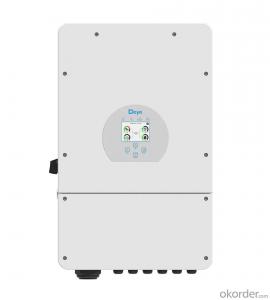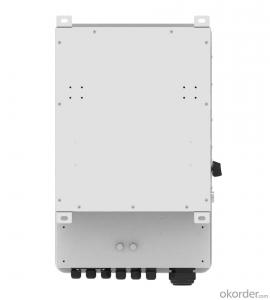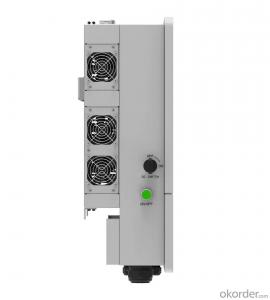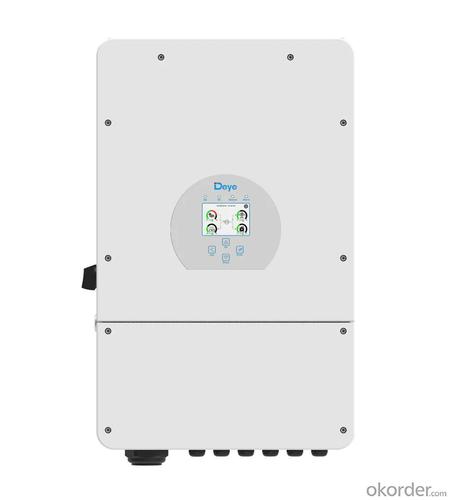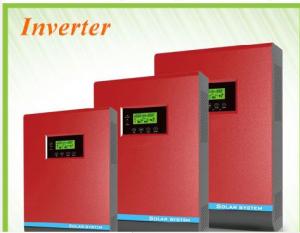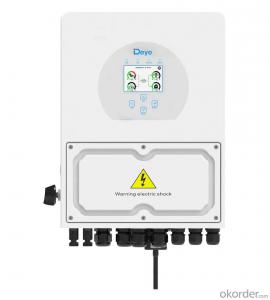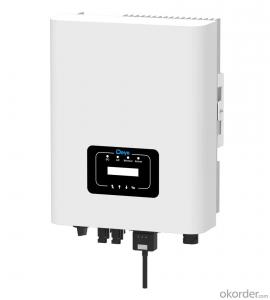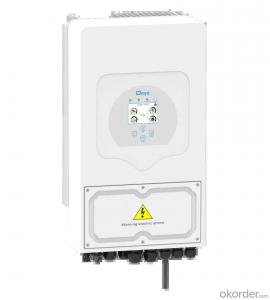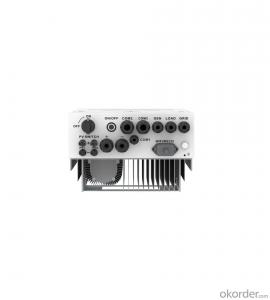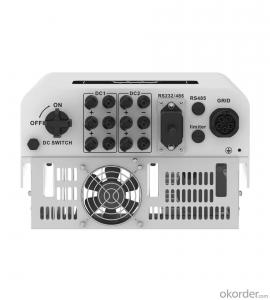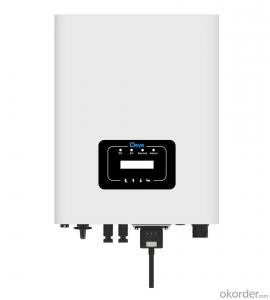Generac Solar Inverter - Sun-12/14/16k-Sg01Lp1 | 12-16kW | Single Phase | 2 MPPT | Hybrid Inverter
- Loading Port:
- Ningbo
- Payment Terms:
- TT OR LC
- Min Order Qty:
- 100 pc
- Supply Capability:
- 5000 pc/month
OKorder Service Pledge
OKorder Financial Service
You Might Also Like
Specification
| Technical Data | ||||||||
| Model | SUN-5K -SG01LP1-US | SUN-6K -SG01LP1-US | SUN-7.6K -SG01LP1-US/EU | SUN-8K -SG01LP1-US/EU | ||||
| Battery Input Data | ||||||||
| Battery Type | Lead-acid or Li-lon | |||||||
| Battery Voltage Range (V) | 40~60 | |||||||
| Max. Charging Current (A) | 120 | 135 | 190 | 190 | ||||
| Max. Discharging Current (A) | 120 | 135 | 190 | 190 | ||||
| External Temperature Sensor | Yes | |||||||
| Charging Curve | 3 Stages / Equalization | |||||||
| Charging Strategy for Li-Ion Battery | Self-adaption to BMS | |||||||
| PV String Input Data | ||||||||
| Max. DC Input Power (W) | 6500 | 7800 | 9880 | 10400 | ||||
| Rated PV Input Voltage (V) | 370 (125~500) | |||||||
| Start-up Voltage (V) | 125 | |||||||
| MPPT Voltage Range (V) | 150-425 | |||||||
| Full Load DC Voltage Range (V) | 300-425 | 200-425 | ||||||
| PV Input Current (A) | 13+13 | 26+13 | 26+26 | |||||
| Max. PV ISC (A) | 17+17 | 34+17 | 34+34 | |||||
| Number of MPPT / Strings per MPPT | 2/1+1 | 2/2+1 | 2/2+2 | |||||
| AC Output Data | ||||||||
| Rated AC Output and UPS Power (W) | 5000 | 6000 | 7600 | 8000 | ||||
| Max. AC Output Power (W) | 5500 | 6600 | 8360 | 8800 | ||||
| AC Output Rated Current (A) | 20.8/24 | 25/28.8 | 31.7/36.5 | 34.5 | 33.3/38.5 | 36.4 | ||
| Max. AC Current (A) | 22.9/26.4 | 27.5/31.7 | 34.8/40.2 | 38 | 36.7/42.3 | 40 | ||
| Max. Continuous AC Passthrough (A) | 40 | 50 | ||||||
| Peak Power (off grid) | 2 time of rated power, 10 S | |||||||
| Power Factor | 0.8 leading to 0.8 lagging | |||||||
| Output Frequency and Voltage | 50 / 60Hz; L1/L2/N(PE) 120/240Vac (split phase), 208Vac (2/3 phase), L/N/PE 220/230Vac (single phase) | |||||||
| Grid Type | Split phase; 2/3 phase; Single Phase | |||||||
| DC injection current (mA) | THD<3% (Linear load<1.5%) | |||||||
| Efficiency | ||||||||
| Max. Efficiency | 97.60% | |||||||
| Euro Efficiency | 97.00% | |||||||
| MPPT Efficiency | 99.90% | |||||||
| Protection | ||||||||
| Integrated | PV Input Lightning Protection, Anti-islanding Protection, PV String Input Reverse Polarity Protection, Insulation Resistor Detection, Residual Current Monitoring Unit, Output Over Current Protection, Output Shorted Protection, Surge protection | |||||||
| Output Over Voltage Protection | DC Type II/AC Type III | |||||||
| Certifications and Standards | ||||||||
| Grid Regulation | CEI 0-21, VDE-AR-N 4105, NRS 097, IEC 62116, IEC 61727, G99, G98, VDE 0126-1-1, RD 1699, C10-11 | |||||||
| Safety EMC / Standard | IEC/EN 61000-6-1/2/3/4, IEC/EN 62109-1, IEC/EN 62109-2 | |||||||
| General Data | ||||||||
| Operating Temperature Range (℃) | -45~60℃, >45℃ derating | |||||||
| Cooling | Smart cooling | |||||||
| Noise (dB) | <30 dB | |||||||
| Communication with BMS | RS485; CAN | |||||||
| Weight (kg) | 32 | |||||||
| Size (mm) | 420W×670H×233D | |||||||
| Protection Degree | IP65 | |||||||
| Installation Style | Wall-mounted | |||||||
| Warranty | 5 years | |||||||
Colorful touch LCD, IP65 protection degree
6 time periods for battery charging/discharging
Max. charging/discharging current of 190A
Max.16pcs parallel
DC couple and AC couple to retrofit existing solar system
Support storing energy from diesel generator
Max. battery charge efficiency of 95.4%
Unique Smart Load application and Grid peak shaving function
4ms fast transfer from on-grid to off-grid mode, ensuing the traditional fixed frequency air conditioner works well
Certified by UL, CE, IEC, VDE, NRS, VFR, AS4777.2, CEI and INMETRO etc.
The series, SUN-5/6K-SG01LP1-US SUN-7.6/8K-SG01LP1-US/EU, is a single-phase low voltage (48V) hybrid inverter that enables enhanced energy independence and maximizes self-consumption through export limit feature and “time of use” function. With the frequency droop control algorithm, this series product supports single phase and three phase parallel application, and the Max. parallel units is up to 16pcs.
- Q: Can a solar inverter be used with solar-powered desalination systems?
- Yes, a solar inverter can be used with solar-powered desalination systems. A solar inverter is essential in converting the direct current (DC) power generated by solar panels into alternating current (AC) power that can be used to operate the desalination system. This allows for the efficient utilization of solar energy for powering the desalination process.
- Q: How does a grid-tied solar inverter work?
- A grid-tied solar inverter converts the direct current (DC) electricity generated by solar panels into alternating current (AC) electricity that can be fed into the electrical grid. It synchronizes the solar panel's electricity with the utility grid's electricity, allowing the excess power to be sent back to the grid or drawing power from the grid when the solar panels are not producing enough. The inverter also ensures the safety and reliability of the system by monitoring the grid's voltage and frequency, and disconnecting in case of grid failure to protect workers and prevent damage to the system.
- Q: Can a solar inverter be used in regions with high levels of air pollution?
- Yes, a solar inverter can be used in regions with high levels of air pollution. Air pollution does not directly impact the functioning of a solar inverter. However, it is important to regularly clean and maintain the solar panels to ensure optimal performance, as air pollution can accumulate on the surface of the panels and reduce their efficiency.
- Q: What is the maximum number of parallel inverters that can be installed in a solar system?
- The maximum number of parallel inverters that can be installed in a solar system depends on various factors such as the capacity of the system, voltage limitations, and the specific requirements of the inverters being used. However, in general, there is no hard limit on the number of parallel inverters that can be installed as long as they are properly designed, coordinated, and meet the system's electrical specifications and safety standards.
- Q: Can a solar inverter be repaired or serviced?
- Yes, a solar inverter can be repaired or serviced. In case of any malfunction or issues, a qualified technician can diagnose and fix the problem. Regular maintenance and servicing can also help prolong the lifespan and optimize the performance of a solar inverter.
- Q: What is the role of a solar inverter in preventing electrical hazards?
- The role of a solar inverter in preventing electrical hazards is to convert the direct current (DC) power generated by solar panels into alternating current (AC) power that can be used in homes and businesses. By regulating the voltage and frequency of the electricity, the inverter ensures that the power is safe and compatible with the electrical grid. Additionally, solar inverters have built-in safety features such as ground fault protection and rapid shutdown mechanisms, which help prevent electrical hazards such as fires, shocks, and damage to the system.
- Q: Are there any limitations on the angle of the solar panels when using a solar inverter?
- Yes, there are limitations on the angle of the solar panels when using a solar inverter. The angle at which solar panels are installed can affect their efficiency and overall performance. Ideally, solar panels should be installed at an angle that allows them to receive maximum sunlight throughout the day. Most solar panels are designed to work optimally when installed at an angle that is equal to the latitude of the location. This angle allows the panels to capture the most sunlight during peak hours. However, this is not a strict rule and variations are possible depending on the specific location and climate conditions. If solar panels are installed at an angle that is too steep or too shallow, it can result in reduced energy production. Steep angles may cause the panels to lose sunlight during certain times of the day, while shallow angles may not allow for optimal sunlight absorption. Additionally, extreme angles can also increase the risk of damage from wind or other weather conditions. It is important to note that modern solar inverters often come with advanced tracking and monitoring technologies that can adapt to different panel angles and orientations. These features can optimize energy production by adjusting the inverter settings based on the real-time performance of the panels. Overall, while there are limitations on the angle of the solar panels, it is crucial to ensure that they are installed in a way that maximizes their exposure to sunlight throughout the day to achieve the highest energy production possible.
- Q: Can a solar inverter be used with a solar-powered electric vehicle charging station?
- Yes, a solar inverter can be used with a solar-powered electric vehicle charging station. The solar inverter helps convert the direct current (DC) power produced by the solar panels into alternating current (AC) power that can be used to charge electric vehicles. This allows for efficient and sustainable charging of electric vehicles using solar energy.
- Q: Can a solar inverter be used for both residential and commercial applications?
- Yes, a solar inverter can be used for both residential and commercial applications. Solar inverters are designed to convert the direct current (DC) electricity generated by solar panels into alternating current (AC) electricity, which is suitable for use in homes and businesses. They are versatile and can be scaled up or down depending on the size of the solar power system, making them suitable for both residential and commercial installations.
- Q: Can a solar inverter be used with different types of solar PV systems (roof-mounted, ground-mounted, etc.)?
- Yes, a solar inverter can be used with different types of solar PV systems, including roof-mounted and ground-mounted systems. Solar inverters are designed to convert the DC (direct current) electricity generated by solar panels into AC (alternating current) electricity that can be used in homes or fed back into the grid. Regardless of the installation type, the solar inverter's function remains the same.
Send your message to us
Generac Solar Inverter - Sun-12/14/16k-Sg01Lp1 | 12-16kW | Single Phase | 2 MPPT | Hybrid Inverter
- Loading Port:
- Ningbo
- Payment Terms:
- TT OR LC
- Min Order Qty:
- 100 pc
- Supply Capability:
- 5000 pc/month
OKorder Service Pledge
OKorder Financial Service
Similar products
Hot products
Hot Searches
Related keywords
